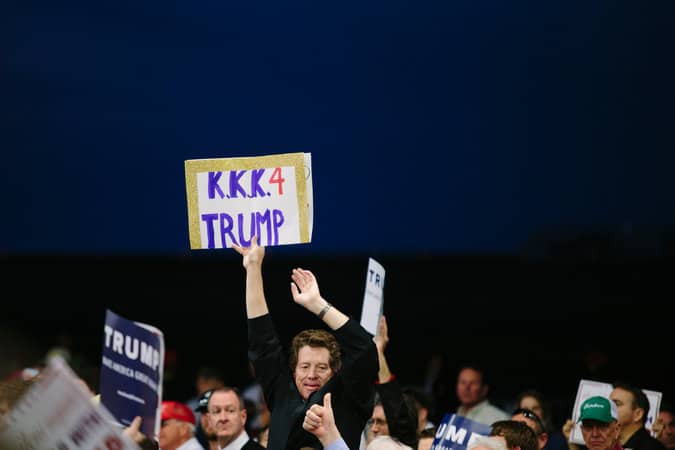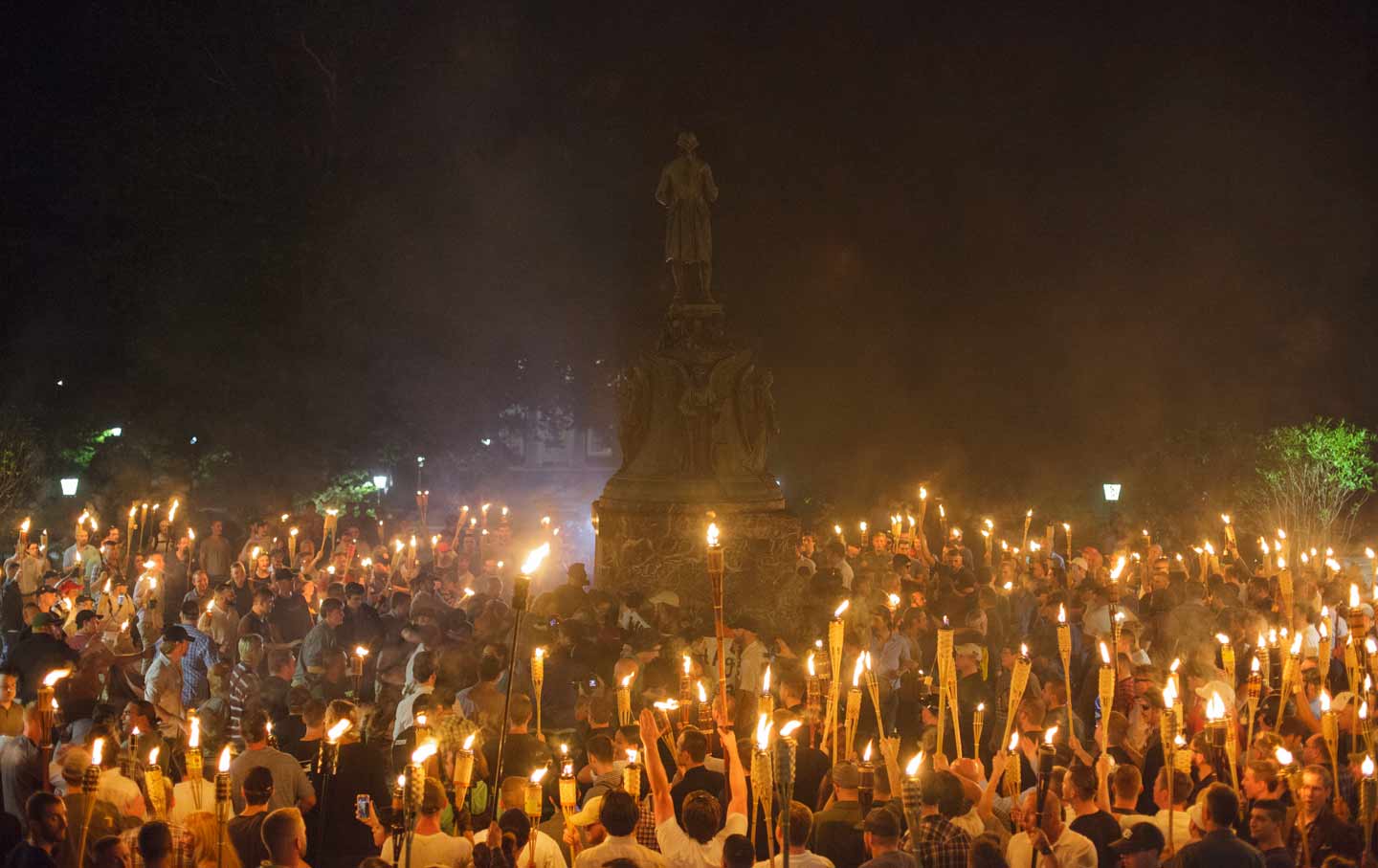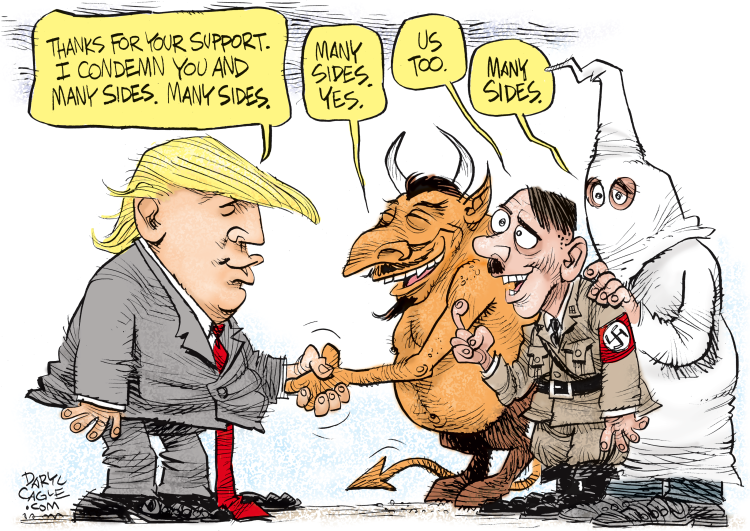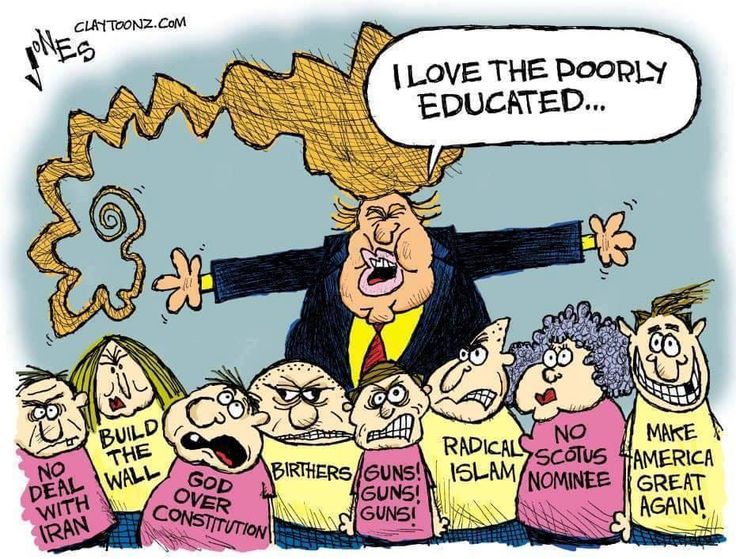Donald Trump and the Twilight of White America
Racial resentment and economic anxiety are not separate forces.
For many Trump supporters, they are inextricably linked.

Reuters
The Atlantic
Derek Thomas
May 13, 2016
Politics
On June 25, 2015, a week after Donald Trump announced his candidacy for president of the United States, the Census Bureau released a landmark report on the demographics of American children under the age of five. For the first time in U.S. history, it reported that a minority of this group is “white”—neither black, nor Asian, nor Hispanic.
The notion of America’s ethnic majority has been dubious for a long time. What today many people call “white” is really a catch-all for various European groups once seen as racially distinct. But this report threw the entire concept into chaos. “A majority of American babies are now minorities,” Bloomberg reported, somewhat paradoxically. In a country where most people are minorities, the majority does not exist. Even within the headline, the word majority is collapsing in on itself.
It is unlikely that a printed copy of this Census report hangs in a gold-plated frame on Trump’s wall. But the specter of America's all-minority future has stalked his campaign. Trump’s core constituency is clear: Republican whites, particularly men, and especially those who didn’t go to college, who feel their American whiteness like a second skin. Many of these first beneficiaries of the franchise now feel disenfranchised. The original middle class feels cut out of the American Dream. The majority is collapsing in on itself.
This moment in American history was inevitable, and it was never going to be a tranquil transition. In 2004, the influential political scientist Samuel Huntington published Who Are We?, his manifesto on the tumultuous future of the American identity. The growth of black and Hispanic minorities, he predicted, would provoke a backlash among whites:
Trump’s platform is a remarkable manifestation of this 12-year-old prophecy. But Even Huntington could not have foreseen that this demographic moment would coincide with an economic crisis (which would be improbably overseen by America’s first black president). History has drawn these conflicts into a crucible, and the economic anxieties and racial anxieties of today are nearly inextricable.
Some of Trump’s policy statements, on issues like the minimum wage and taxes, are like wisps of smoke—coming into existence, curling into strange shapes, and disappearing within moments. But his bedrock promises all relate to the white American middle’s central fears, including Hispanic immigration and global trade.
It is not enough to say that Trump is a purely racial phenomenon. Nor is it complete to argue that he is the perfectly predictable result of economic upheaval.
The grievances of middle-class white Americans are not make-believe, nor is their nostalgia misplaced. The 1950s was a remarkable decade for blue-collar male workers. Union membership in the private sector peaked at 35 percent. The male labor-participation rate peaked in 1951. The next year, unemployment fell under 3 percent for the only period on record. Factories that once made shrapnel turned out lawn mowers and washing machines that supplied a happy migration to the suburbs. All this occurred within an economy that was uniquely closed, as the economist Robert Gordon wrote in his book The Rise and Fall of American Growth:
The high tariff wall allowed American manufacturing to introduce all available innovations into U.S.-based factories without the outsourcing that has become common in the last several decades. The lack of competition from immigrants and imports boosted the wages of workers at the bottom and contributed to the remarkable “great compression” of the income distribution during the 1940s, 1950s, and 1960s. Thus the closing of the American economy through restrictive immigration legislation and high tariffs may indirectly have contributed to the rise of real wages … and the general reduction of inequality from the 1920s to the 1950s.
For white American middle-class men, especially those without a college degree, it was the best of times. What happened? The road from there to Trump is long and punctuated with many markers. But here are three significant turns: the 1968 election; the 1979 peak in manufacturing employment, and the 2008 election of Barack Obama. Together, these episodes made economic anxiety and promoted racial resentment a dual-headed political weapon, and Donald Trump grabbed it.
In the late 1960s, after two Democratic presidents, John F. Kennedy and Lyndon B. Johnson, fought to extend rights to black Americans, many southern whites abandoned the Democratic party. Richard Nixon and other politicians worked to peel away white voters by appealing to their resentment of African Americans. Rather than an outright call for a repeal to the Civil Rights Act, these Republicans offered an economic agenda that would bolster whites at the expense of blacks. In a shockingly frank 1981 interview looking back at the 1968 election, the Republican strategist Lee Atwater explained how Nixon disguised his appeal to anti-black voters in the language of economic angst.
“By 1968 you can’t say ‘******’—that hurts you, backfires. So you say stuff like, uh, forced busing, states’ rights, and all that stuff, and you’re getting so abstract. Now, you’re talking about cutting taxes, and all these things you’re talking about are totally economic things and a byproduct of them is, blacks get hurt worse than whites.”
Was the white south’s shift to the Republican column really all about civil rights? In a 2015 study, Yale University researchers drawing from Gallup surveys dating back to 1958 concluded that although southern white Democrats held racist views before the 1960s, the correlation between “conservative racial views” and “Democratic identification” disappeared after Kennedy proposed the Civil Rights Act in 1963. Essentially, almost all of those voters became Republicans. “Defection among racially conservative whites explains all of the decline in relative white Southern Democratic identification between 1958 and 1980” and three-quarters of the decline until 2000, they concluded.
Trump’s presumptive GOP victory would have been impossible without his strength in states cordoned off by the Southern Strategy. Of the 11 former confederate state in the survey—Alabama, Arkansas, Florida, Georgia, Louisiana, Mississippi, North Carolina, South Carolina, Tennessee, Texas and Virginia—Trump won 10. He might have won the 11th, Texas, were it not the home state of his chief rival, Ted Cruz. Trump has never explicitly trumpeted white American supremacy, and yet he seems to effortlessly attract the support of white American supremacists, like David Duke, William Johnson, and the sensational alt-right. Dog-whistling might be the appropriate term. But it’s not a dog whistle if everybody can hear you.
The 1968 election made race key to the southern white Republican voting bloc. But still, the economy was roaring. Real GDP grew 5 percent in 1968, twice as fast as any year since the Great Depression, and the economy expanded steadily throughout the decade.
Yet trouble was approaching the form of globalization and technology. The most important American industry for most of the 20th century had been manufacturing. Once employing more than a third of the private workforce, and mostly men without a college education, manufacturing employment peaked in the summer of 1979 at almost 20 million workers. But by the end of the early 1980s recession, the sector had lost almost 3 million jobs. Today, there are about 12 million people working in manufacturing, altogether. In the cities where these jobs were concentrated, the fallout was particularly brutal. Youngstown, Ohio, was once one of the richest metropolitan areas in the country by median wage. But after the 1977 shuttering of its Campbell Works mill, it lost 50,000 jobs and $1.3 billion in manufacturing wages, a downturn so severe that economists had to invent a new term to describe it: “regional depression.”
Manufacturing provided steady work for unionized workers without a four-year diploma. When it collapsed, so did unions and the fortunes of non-college men. Since 1980, the share of men between 25 and 54 who are neither working nor looking for work has increased with each passing decade. Since 1980, this figure, called the "inactivity rate," has more than doubled. Meanwhile, work has shifted toward service-sector jobs where less-educated women have fared better than men. Women without a college degree are earning more than they were 20 years ago, but since 1990, median real earnings for men without a college degree have fallen 13 percent. This despair even shows up in mortality statistics. In November 2015, in the middle of Trump’s ascent, Princeton economists Angus Deaton and Anne Case discovered that only one age-and-ethnic group is dying at higher rates than they were 15 years ago: middle-aged American whites without a college education.
There is some evidence that Trump attracts some upper-class support. But men without a diploma remain the very core of his voting bloc, and Trump has explicitly cultivated their votes by promised to bring back the 1979 economy. “They’re stealing our jobs,” he said of China, now the world’s largest manufacturing economy. “They’re beating us in everything; they’re winning, we’re losing.”
In February 2011, a national survey by the Washington Post, the Kaiser Family Foundation, and Harvard University found that white men without a college degree had a uniquely dark outlook on America's future. They were the most likely to say the country's best days are over; the most likely to be pessimistic about the economy's future; and the most likely to say hard work no longer guarantees success.
Their economic despair has mixed with racial resentment. In 2004, white Republicans and white Democrats were similarly likely to say that "too much" money was spent to improve conditions for black people. Eight years later, Republicans were three times more likely to agree. When Nate Silver measured responses to several race-related questions in the General Population Survey, he concluded that, although the expression of racism by all whites toward blacks has decreased over time, "they’ve failed to decrease under Obama” among Republicans.
The reemergence of racial antagonism is concentrated among Trump supporters. Six out of ten of them think Obama is a Muslim, and only 21 percent acknowledge that the president was born in the United States.
Racism doesn’t need economic insecurity to thrive. The 1950s saw both historic income growth and considerable racism under Jim Crow. But economic anxiety can amplify racial threat effects by leading the majority to fear losing scarce resources to the rising minority. According to "group position theory,” or “group threat,” people in an ethnic majority identify with each other and feel threatened when their position in the cultural hierarchy is tenuous. There is evidence from Europe, for example, that the more people think that immigrants are likely to compete for jobs, the more likely they are to support reduced levels of immigration. A paper from May 2016 from researchers at Stanford University, the University of Toronto, and the University of California, Berkeley, applied group position theory to the rise of the Tea Party, arguing that racial resentment was the motor of the movement. They concluded that “the election of the first nonwhite president [and] the rising minority population have been perceived as threatening the relative standing of whites in the U.S.”
In short, scarcity triggers tribalism. Despite the long decline in racism among most American voters, prejudice is blooming where voters are most pessimistic and afraid. Economic anxiety and racial anxiety are not separate forces, but rather a growing, snarling hydra.
Certainly, many racists are not poor, and many poor whites are not racist. But for many voters, race and economics are not separate issues. Again and again in the last half century, they have been intertwined in ways that were sometimes hard to see at the time:
Notes[/paste:font]
But the minority nation is coming, no matter how much Trump’s supporters resent it. In 2016, 27 million Hispanics will be able to vote, and almost half of them were born after 1980; this will be true even if immigration is permanently halted and some undocumented workers are sent home. Meanwhile, opinion toward immigrants is improving nationwide. In 1994, more than 60 percent of both Republicans and Democrats said immigrants were a burden on the country because they took jobs and health care. In fall 2015, just 17 percent of Democrats agreed; in fact, more than three-quarters of people under 35 said immigrants strengthen the country. If this is struggle over the future of America’s ethnicity, Trump’s supporters are fighting a battle in a war they have already lost.
Several weeks ago, The Atlantic’s David Graham wrote about the way Trump uses the word “we.” The word is inherently inclusive, yet Trump uses it to exclude. “For Trump, blacks and Hispanics aren’t part of ‘we’,” Graham wrote. “‘They” constitute separate groups.”
We and they. My group and your group. Like quarks and leptons, these ideas-are the sub-atomic building blocks of politics. Huntington knew it, predicting the Trump phenomenon in 2004, when he named his book Who Are We? Huntington believed in a national identity bound up in whiteness. So do millions of voters. But the math of demography is stark. In 2033, the U.S. Census will record that half of 18-year-olds showing up to vote for the first time will be non-white. Young voters will belong to an electoral cohort that claims no majority. In November, tens of millions of voters may choose resentment over acceptance of this inevitability. But if they do, then who are we?
SOURCE: http://www.theatlantic.com/politics...ump-and-the-twilight-of-white-america/482655/
.
Racial resentment and economic anxiety are not separate forces.
For many Trump supporters, they are inextricably linked.

Reuters
The Atlantic
Derek Thomas
May 13, 2016
Politics
On June 25, 2015, a week after Donald Trump announced his candidacy for president of the United States, the Census Bureau released a landmark report on the demographics of American children under the age of five. For the first time in U.S. history, it reported that a minority of this group is “white”—neither black, nor Asian, nor Hispanic.
The notion of America’s ethnic majority has been dubious for a long time. What today many people call “white” is really a catch-all for various European groups once seen as racially distinct. But this report threw the entire concept into chaos. “A majority of American babies are now minorities,” Bloomberg reported, somewhat paradoxically. In a country where most people are minorities, the majority does not exist. Even within the headline, the word majority is collapsing in on itself.
It is unlikely that a printed copy of this Census report hangs in a gold-plated frame on Trump’s wall. But the specter of America's all-minority future has stalked his campaign. Trump’s core constituency is clear: Republican whites, particularly men, and especially those who didn’t go to college, who feel their American whiteness like a second skin. Many of these first beneficiaries of the franchise now feel disenfranchised. The original middle class feels cut out of the American Dream. The majority is collapsing in on itself.
This moment in American history was inevitable, and it was never going to be a tranquil transition. In 2004, the influential political scientist Samuel Huntington published Who Are We?, his manifesto on the tumultuous future of the American identity. The growth of black and Hispanic minorities, he predicted, would provoke a backlash among whites:
The various forces challenging the core American culture and creed could generate a move by native white Americans to revive the discarded and discredited racial and ethnic concepts of American identity and to create an America that would exclude, expel, or suppress people of other racial, ethnic, and cultural groups. Historical and contemporary experience suggest that this is a highly probable reaction from a once dominant ethnic-racial group that feels threatened by the rise of other groups. It could produce a racially intolerant country with high levels of intergroup conflict.
Trump’s platform is a remarkable manifestation of this 12-year-old prophecy. But Even Huntington could not have foreseen that this demographic moment would coincide with an economic crisis (which would be improbably overseen by America’s first black president). History has drawn these conflicts into a crucible, and the economic anxieties and racial anxieties of today are nearly inextricable.
Some of Trump’s policy statements, on issues like the minimum wage and taxes, are like wisps of smoke—coming into existence, curling into strange shapes, and disappearing within moments. But his bedrock promises all relate to the white American middle’s central fears, including Hispanic immigration and global trade.
- In his first 100 days, he says, he would act to close the country.
- He would send additional security to the south and seal the Mexican border.
- He would begin the design and construction of the Mexican Wall.
- He would initiate plans to round up more than 10 million undocumented immigrants to send them overseas.
- He would potentially ban Muslim immigrants from entering the county.
It is not enough to say that Trump is a purely racial phenomenon. Nor is it complete to argue that he is the perfectly predictable result of economic upheaval.
Rather, in the last half-century, several events have pushed conservative white American middle-class men to conflate their majoritarian, economic, and cultural decline. Economic anxiety and racial resentment are not entirely separate things, but rather like buttresses in an arch, supporting each other in the creation of something larger—Donald Trump.
The grievances of middle-class white Americans are not make-believe, nor is their nostalgia misplaced. The 1950s was a remarkable decade for blue-collar male workers. Union membership in the private sector peaked at 35 percent. The male labor-participation rate peaked in 1951. The next year, unemployment fell under 3 percent for the only period on record. Factories that once made shrapnel turned out lawn mowers and washing machines that supplied a happy migration to the suburbs. All this occurred within an economy that was uniquely closed, as the economist Robert Gordon wrote in his book The Rise and Fall of American Growth:
The high tariff wall allowed American manufacturing to introduce all available innovations into U.S.-based factories without the outsourcing that has become common in the last several decades. The lack of competition from immigrants and imports boosted the wages of workers at the bottom and contributed to the remarkable “great compression” of the income distribution during the 1940s, 1950s, and 1960s. Thus the closing of the American economy through restrictive immigration legislation and high tariffs may indirectly have contributed to the rise of real wages … and the general reduction of inequality from the 1920s to the 1950s.
For white American middle-class men, especially those without a college degree, it was the best of times. What happened? The road from there to Trump is long and punctuated with many markers. But here are three significant turns: the 1968 election; the 1979 peak in manufacturing employment, and the 2008 election of Barack Obama. Together, these episodes made economic anxiety and promoted racial resentment a dual-headed political weapon, and Donald Trump grabbed it.
In the late 1960s, after two Democratic presidents, John F. Kennedy and Lyndon B. Johnson, fought to extend rights to black Americans, many southern whites abandoned the Democratic party. Richard Nixon and other politicians worked to peel away white voters by appealing to their resentment of African Americans. Rather than an outright call for a repeal to the Civil Rights Act, these Republicans offered an economic agenda that would bolster whites at the expense of blacks. In a shockingly frank 1981 interview looking back at the 1968 election, the Republican strategist Lee Atwater explained how Nixon disguised his appeal to anti-black voters in the language of economic angst.
“By 1968 you can’t say ‘******’—that hurts you, backfires. So you say stuff like, uh, forced busing, states’ rights, and all that stuff, and you’re getting so abstract. Now, you’re talking about cutting taxes, and all these things you’re talking about are totally economic things and a byproduct of them is, blacks get hurt worse than whites.”
Was the white south’s shift to the Republican column really all about civil rights? In a 2015 study, Yale University researchers drawing from Gallup surveys dating back to 1958 concluded that although southern white Democrats held racist views before the 1960s, the correlation between “conservative racial views” and “Democratic identification” disappeared after Kennedy proposed the Civil Rights Act in 1963. Essentially, almost all of those voters became Republicans. “Defection among racially conservative whites explains all of the decline in relative white Southern Democratic identification between 1958 and 1980” and three-quarters of the decline until 2000, they concluded.
Trump’s presumptive GOP victory would have been impossible without his strength in states cordoned off by the Southern Strategy. Of the 11 former confederate state in the survey—Alabama, Arkansas, Florida, Georgia, Louisiana, Mississippi, North Carolina, South Carolina, Tennessee, Texas and Virginia—Trump won 10. He might have won the 11th, Texas, were it not the home state of his chief rival, Ted Cruz. Trump has never explicitly trumpeted white American supremacy, and yet he seems to effortlessly attract the support of white American supremacists, like David Duke, William Johnson, and the sensational alt-right. Dog-whistling might be the appropriate term. But it’s not a dog whistle if everybody can hear you.
The 1968 election made race key to the southern white Republican voting bloc. But still, the economy was roaring. Real GDP grew 5 percent in 1968, twice as fast as any year since the Great Depression, and the economy expanded steadily throughout the decade.
Yet trouble was approaching the form of globalization and technology. The most important American industry for most of the 20th century had been manufacturing. Once employing more than a third of the private workforce, and mostly men without a college education, manufacturing employment peaked in the summer of 1979 at almost 20 million workers. But by the end of the early 1980s recession, the sector had lost almost 3 million jobs. Today, there are about 12 million people working in manufacturing, altogether. In the cities where these jobs were concentrated, the fallout was particularly brutal. Youngstown, Ohio, was once one of the richest metropolitan areas in the country by median wage. But after the 1977 shuttering of its Campbell Works mill, it lost 50,000 jobs and $1.3 billion in manufacturing wages, a downturn so severe that economists had to invent a new term to describe it: “regional depression.”
Manufacturing provided steady work for unionized workers without a four-year diploma. When it collapsed, so did unions and the fortunes of non-college men. Since 1980, the share of men between 25 and 54 who are neither working nor looking for work has increased with each passing decade. Since 1980, this figure, called the "inactivity rate," has more than doubled. Meanwhile, work has shifted toward service-sector jobs where less-educated women have fared better than men. Women without a college degree are earning more than they were 20 years ago, but since 1990, median real earnings for men without a college degree have fallen 13 percent. This despair even shows up in mortality statistics. In November 2015, in the middle of Trump’s ascent, Princeton economists Angus Deaton and Anne Case discovered that only one age-and-ethnic group is dying at higher rates than they were 15 years ago: middle-aged American whites without a college education.
There is some evidence that Trump attracts some upper-class support. But men without a diploma remain the very core of his voting bloc, and Trump has explicitly cultivated their votes by promised to bring back the 1979 economy. “They’re stealing our jobs,” he said of China, now the world’s largest manufacturing economy. “They’re beating us in everything; they’re winning, we’re losing.”
In February 2011, a national survey by the Washington Post, the Kaiser Family Foundation, and Harvard University found that white men without a college degree had a uniquely dark outlook on America's future. They were the most likely to say the country's best days are over; the most likely to be pessimistic about the economy's future; and the most likely to say hard work no longer guarantees success.
Their economic despair has mixed with racial resentment. In 2004, white Republicans and white Democrats were similarly likely to say that "too much" money was spent to improve conditions for black people. Eight years later, Republicans were three times more likely to agree. When Nate Silver measured responses to several race-related questions in the General Population Survey, he concluded that, although the expression of racism by all whites toward blacks has decreased over time, "they’ve failed to decrease under Obama” among Republicans.
The reemergence of racial antagonism is concentrated among Trump supporters. Six out of ten of them think Obama is a Muslim, and only 21 percent acknowledge that the president was born in the United States.
Racism doesn’t need economic insecurity to thrive. The 1950s saw both historic income growth and considerable racism under Jim Crow. But economic anxiety can amplify racial threat effects by leading the majority to fear losing scarce resources to the rising minority. According to "group position theory,” or “group threat,” people in an ethnic majority identify with each other and feel threatened when their position in the cultural hierarchy is tenuous. There is evidence from Europe, for example, that the more people think that immigrants are likely to compete for jobs, the more likely they are to support reduced levels of immigration. A paper from May 2016 from researchers at Stanford University, the University of Toronto, and the University of California, Berkeley, applied group position theory to the rise of the Tea Party, arguing that racial resentment was the motor of the movement. They concluded that “the election of the first nonwhite president [and] the rising minority population have been perceived as threatening the relative standing of whites in the U.S.”
In short, scarcity triggers tribalism. Despite the long decline in racism among most American voters, prejudice is blooming where voters are most pessimistic and afraid. Economic anxiety and racial anxiety are not separate forces, but rather a growing, snarling hydra.
Certainly, many racists are not poor, and many poor whites are not racist. But for many voters, race and economics are not separate issues. Again and again in the last half century, they have been intertwined in ways that were sometimes hard to see at the time:
- The success of the Southern Strategy encouraged many conservatives to broadcast racially charged messages in the abstract language of economics and government spending.
- The decline of manufacturing created a widespread culture of economic anxiety which, as predicted by group threat theory, often breeds minority resentment.
- For many, the Great Recession and the election of Obama brought these forces of racial anxiety and economic anxiety together. The growth of minority demographics coincided with growing middle-class economic despair, and Republicans responded by questioning the legitimacy of America’s first black president and building coalitions that united racially resentful whites, like the Tea Party and the Trump movement. Meanwhile, surveys show that Republicans’ long-improving racial attitudes suddenly reversed when Obama became president.
Notes[/paste:font]
But the minority nation is coming, no matter how much Trump’s supporters resent it. In 2016, 27 million Hispanics will be able to vote, and almost half of them were born after 1980; this will be true even if immigration is permanently halted and some undocumented workers are sent home. Meanwhile, opinion toward immigrants is improving nationwide. In 1994, more than 60 percent of both Republicans and Democrats said immigrants were a burden on the country because they took jobs and health care. In fall 2015, just 17 percent of Democrats agreed; in fact, more than three-quarters of people under 35 said immigrants strengthen the country. If this is struggle over the future of America’s ethnicity, Trump’s supporters are fighting a battle in a war they have already lost.
Several weeks ago, The Atlantic’s David Graham wrote about the way Trump uses the word “we.” The word is inherently inclusive, yet Trump uses it to exclude. “For Trump, blacks and Hispanics aren’t part of ‘we’,” Graham wrote. “‘They” constitute separate groups.”
We and they. My group and your group. Like quarks and leptons, these ideas-are the sub-atomic building blocks of politics. Huntington knew it, predicting the Trump phenomenon in 2004, when he named his book Who Are We? Huntington believed in a national identity bound up in whiteness. So do millions of voters. But the math of demography is stark. In 2033, the U.S. Census will record that half of 18-year-olds showing up to vote for the first time will be non-white. Young voters will belong to an electoral cohort that claims no majority. In November, tens of millions of voters may choose resentment over acceptance of this inevitability. But if they do, then who are we?
SOURCE: http://www.theatlantic.com/politics...ump-and-the-twilight-of-white-america/482655/
.























